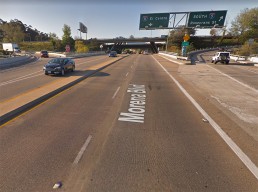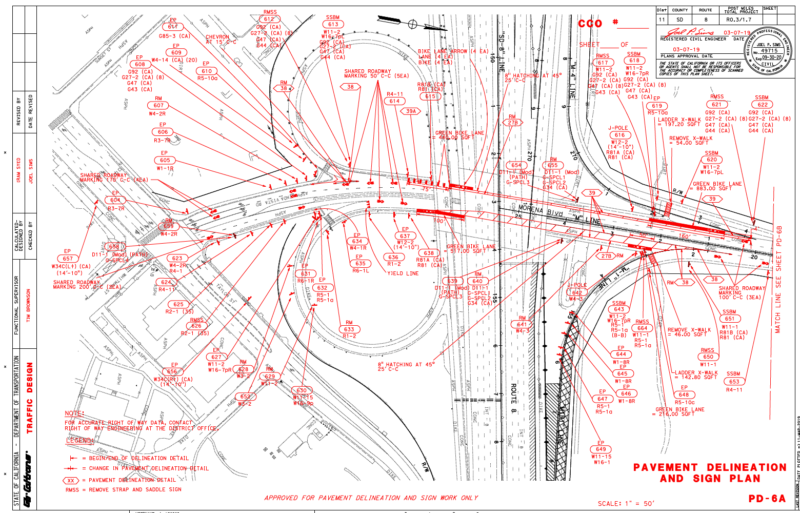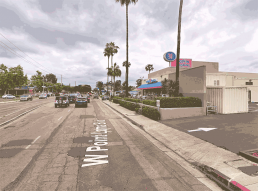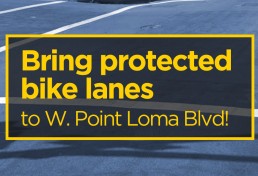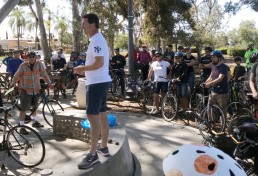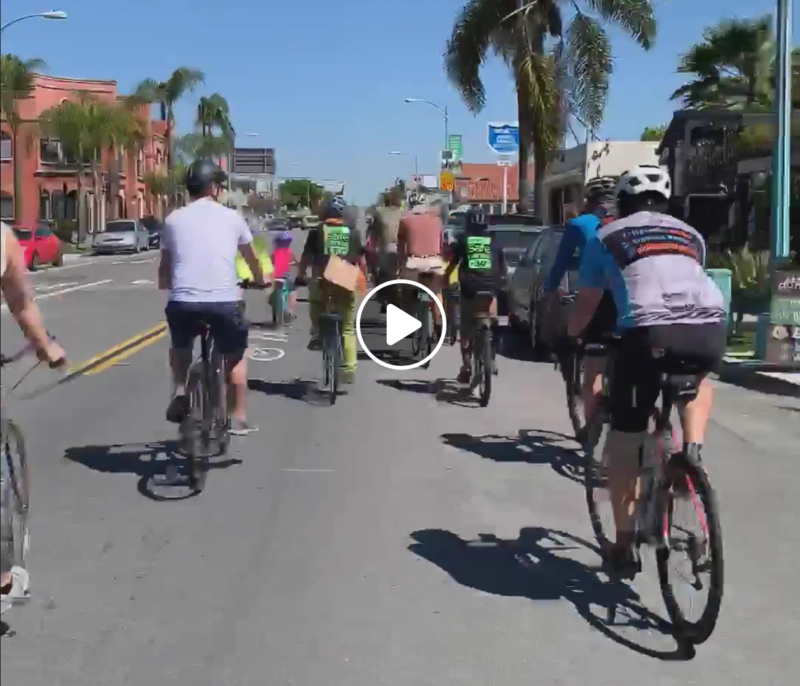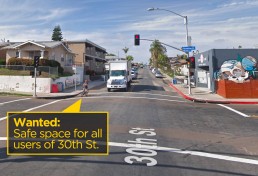Bike markings coming to Morena Blvd at the Interstate 8 crossing
New bike striping plans and signage for bike riders will be implemented on Morena Boulevard where it crosses Interstate 8 in the next few months. This is an exciting moment in time when Caltrans takes the opportunity to implement safe street markings on state-controlled interchanges that can provide additional guidance, safety, and comfort for people riding bikes.
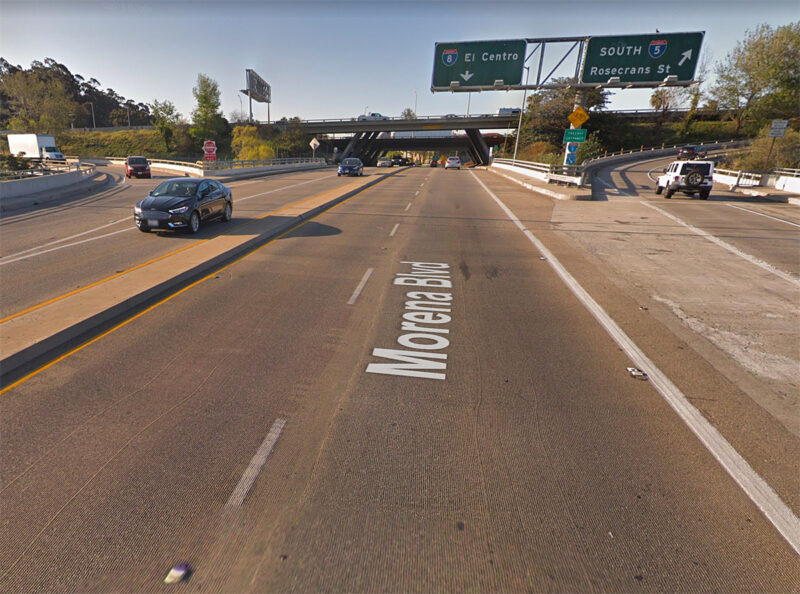 These Morena Blvd stripings were triggered when BikeSD Board President Nicole Burgess rode through the area and sent a tweet to Caltrans more than one year ago. She requested @CaltransSD provide safer connections through this corridor which would connect to the City’s efforts that implemented bike lanes and facility improvements on the north end of the corridor. Her request has been granted.
These Morena Blvd stripings were triggered when BikeSD Board President Nicole Burgess rode through the area and sent a tweet to Caltrans more than one year ago. She requested @CaltransSD provide safer connections through this corridor which would connect to the City’s efforts that implemented bike lanes and facility improvements on the north end of the corridor. Her request has been granted.
Caltrans Pedestrian and Bicycle Committee has discussed this project at the last two meetings and attached are the new striping plans and signage that will be implemented. BikeSD is glad to see that Caltrans is taking the initiative to provide better facilities throughout their jurisdiction. We appreciate collaborative efforts by Caltrans as they engaged and worked with the bike community to get the best improvements that can be made with paint. Obviously, there are better ways to improve the corridor but not without lots of money to tie up the interchanges (which is not happening anytime soon).
The plans shown above (see PDF for high-resolution drawings) are quite detailed. Overall BikeSD is supportive of these improvements. One concern that BikeSD and other bike advocates suggested was to add "Green Dashed Paint Markings through the Intersection” per NACTO guidelines. This was a consistent request by many people who ride bikes, but unfortunately the Operations Team at Caltrans is not willing to do so. We've inquired to understand what prevents Caltrans from implementing these types of paint markings and will keep our members posted on Caltrans response.
Regardless, we're looking forward to better striping through this area and thank Caltrans for their efforts. As the improvements are made in the next few months, we hope that you appreciate the new facility markings. Feel free to send a tweet or email to @CaltransSD thanking them for the new improvements and any concerns you may observe as a bike rider.
Support BikeSD's advocacy by becoming a memberA Wonderful Transformation for West Point Loma Blvd
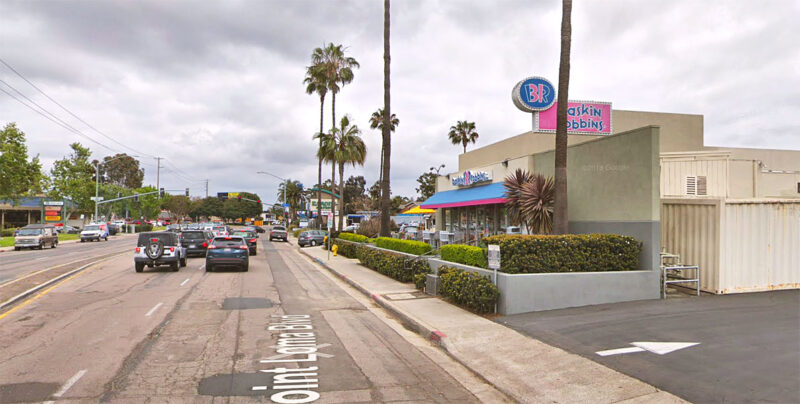
Yay - I will finally be able to safely ride my bike down West Point Loma Blvd to get ice cream at 31 Flavors. And I can stop at Barons and Grocery Outlet for some groceries. And the next day, I might hit the bank and enjoy a yoga class. A short bike ride to local businesses is a great amenity for all of us.
I am truly grateful for the community of Ocean Beach and Point Loma for supporting this amazing opportunity to repurpose our streets as they are resurfaced. Many thanks also to Council Member Campbell for supporting a Class IV bikeway to provide a safe facility for all ages and abilities. Repurposing our streets as they are resurfaced is a very cost-effective approach to making our streets safer while providing an option for more people to bike, walk, and roll. And West Point Loma is a perfect example.
The segment along West Point Loma Blvd from Nimitz Blvd to Sports Arena Blvd will be going on a “road diet” or shall we say it is being transformed to accommodate all users of the road. Vehicle lanes will be reduced to one lane in each direction but the choke points at the west and east end will not be changed, meaning all turn lanes towards Nimitz and Sports Arena/Midway will remain. Reducing the number of vehicle lanes will provide the space for a safe and comfortable bikeway, also referred to as a Class IV Bikeway or Cycle Track. The reduction of lanes will create traffic calming to foster safer driving behaviors. Speeds will be reduced but the average travel time through this corridor will be relatively the same (approximately a 4 second delay). This small few seconds is well worth the safety benefits for all. We applaud the City of SD for implementing a true Vision Zero Solution for Safety as the recommended treatment and support the City’s goals for safety to be a top priority.
There are other benefits to the neighborhood: home values will likely increase, parents can let their kids get to their neighborhood schools by foot or bike, and more people will be out and about visiting local business and being social. This all creates a more vibrant, healthy, and enjoyable place to live, work, and play.
Just in time for summer, our neighbors to the east of Nimitz, can now safely hop on their bike and safely pedal to the beach and best of all, they will not have to worry about parking a car. They will now have the best front row parking on the sand, all without contributing to traffic on Sunset Cliffs. I look forward to sharing smiles with new riders in the neighborhood. Thank you again, to all of you, for supporting a healthy lifestyles and a healthy future. Ride on…
Advocacy Alert: Bring Protected Bike Lanes to West Point Loma Blvd

Thursday, April 18, 2010 - 6 PM to 8:30 PM
Peninsula Community Planning Board Meeting
Location: Point Loma Library, 3701 Voltaire Street, San Diego, CA 92107
Come voice your support for fully-protected Class IV bike lanes along West Point Loma Blvd. The City of San Diego is presenting this option to the Peninsula Community Planning Board. It's critical that bike and street safety advocates come and support this project to help create an amazing transformation of a neighborhood street and provide a wonderful bike facility for all ages and abilities.
Spread the word and help show support for this opportunity to create safer streets in the community.
More than 150 riders use "people-protected bike lane" to call for safe 30th Street bike lanes
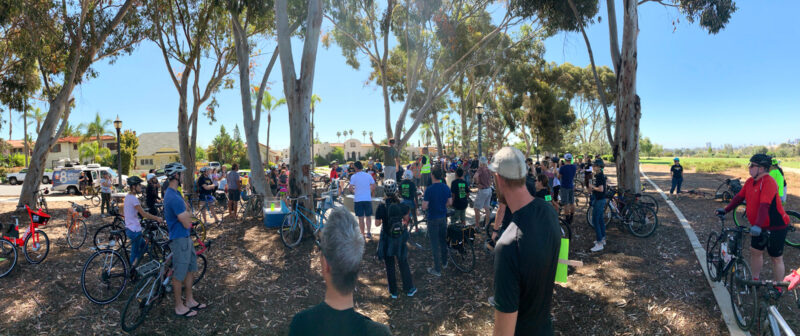
On Saturday morning, scores of North Park families and friends turned out to call for protected bike lanes on 30th Street. From 6 year olds on training wheels to 66 year olds on road bikes, the mood was joyous as District 3 Councilmember Chris Ward and staff from the Mayor's office spoke and rode in support of creating protected bike lanes on 30th Street. And then more than 150 bike riders led by BikeSD board president Nicole Burgess set off from Bird Park to create a line of bike riders stretched for blocks along 30th Street. And in a first for San Diego, these riders passed through a "people-protected lane" created by two dozen activists on the very street where the city of San Diego is considering adding new bike lanes.
The message was clear: North Park residents want streets that are safe for all ages, that help the city meet its climate goals, and that give them more options for getting around the neighborhood. Organizer and local resident Matt Stucky partnered with BikeSD, Climate Action Campaign, the San Diego County Bike Coalition, and CirculateSD to create an event that highlighted the possibilities for a safer, better 30th Street just days before the City presents its new street design for 30th at the North Park Planning Committee on Tuesday night, April 16.
If you haven't seen the coverage by Angie Lee on CBS8 News check it out: https://www.cbs8.com/article/life/family/cycling-activists-rally-for-protected-bike-lanes-in-san-diego/509-1526e805-92d1-4f1f-91ee-85fb71bc9697
Or see some other video posts of this event right below:
or watch a time lapse video from inside the ride (Facebook):
BikeSD urges our members to come to the North Park Planning meeting: Tuesday, April 16, 6:30-8:30 pm, located at North Park Christian School, 2901 North Park Way. Event details on Facebook here: https://www.facebook.com/events/333399813966754/. Come!
30th Street Bikeway Update - We Have a Real Opportunity
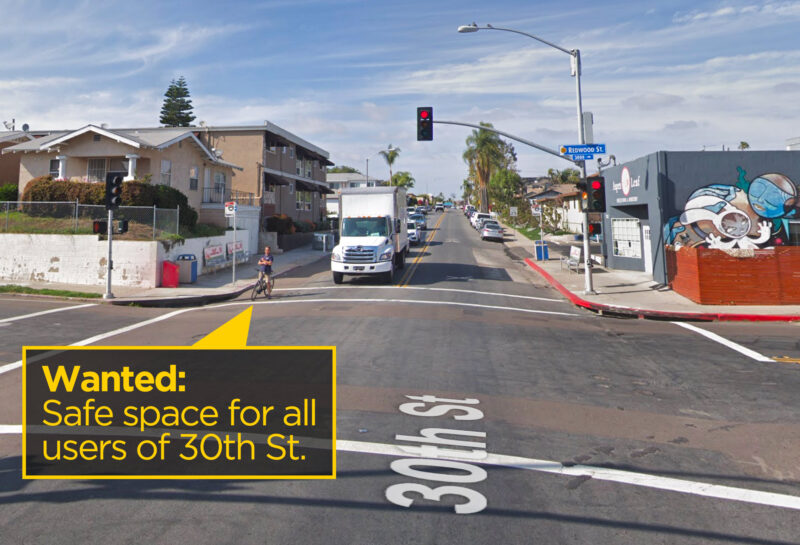
There’s a real opportunity for a transformative redesign of one of San Diego’s premiere urban streets — if we remind the city of its Complete Streets, Vision Zero and Climate Action Plan policies.
Just last week, the city started community outreach to gauge support for adding bike lanes to 30th Street from Juniper Street north to Howard Street following the pipeline replacement project. Councilmember Chris Ward’s office held the first of three meetings to solicit community input. After a preliminary study, city engineers concluded that two design options were feasible. The first option would add “Class II” bike lanes either against the curb south of Upas or between parked cars and the automobile traffic north of Upas. The second option would add protected bike lanes for the entire segment — called a “cycletrack,” the safest kind of on-street bike path.
[ UPDATE: April 4, 2019 - KPBS covers the story: https://www.kpbs.org/news/2019/apr/04/activists-rallying-protected-bike-lanes-north-park/ ]
Preserving parking spaces?
Unfortunately, city staff prepared a preliminary design based only on the first of these two options (drawings for northern section and for southern section). As explained by city staff, the preliminary striping plan was created to strike a compromise between the current bikeway-lacking roadway design and the need to preserve as much street parking as possible. Rather than a protected bikeway, the city’s design removes a small number of parking spaces but still makes bicyclists and scooter users ride between the automobile traffic and parked cars, exposing riders to the dangers of being “doored” (i.e., colliding with a car door) and getting thrown into traffic.

This is the similar minimal design that led to a cyclist’s death last week in San Francisco and prompted a quick fix to upgrade to a protected bike lane by removing parking. As San Francisco’s transit agency acknowledged, the death was preventable if the better design had been originally implemented.
Sharrows?
In the City’s proposed design for 30th Street, the section south of Upas is even less safe: bike lanes are placed only in some areas, and the city proposes using ‘sharrows’ — which require cyclists to share the lane with cars going between 25-35 miles per hour:

There are two main problems with the preliminary striping design. First, it contradicts the city’s own policies in North Park to design “complete streets” for all users. As defined in the community plan, a complete street is “designed for everyone in mind, for people of all ages and abilities using multiple modes of transit in lieu of car-oriented streets that are designed to primarily accommodate the automobile.” At the first community meeting, city staff admitted that the preliminary design was not an “8-80” facility, meaning one designed for users from the ages of 8 to 80.
CAP goals missed
Second, the preliminary design doesn’t go far enough to honor the city’s commitments to reach the binding targets of its Climate Action Plan (CAP): to reduce the number of car trips and increase the share of walking, biking, and non-car trips in the city.
The CAP goals shaped the debate about the North Park Community Plan, one of the first community plan updates passed after the CAP. When the update was being crafted in 2016, an analysis by the city showed that the proposed street design in the adopted plan was not enough, standing alone, for the city to achieve its CAP goals.
The City reassured the city council and community that it could meet the CAP goals because the community plan “does not account for other programs and policies that would be implemented throughout the life of the community plans, such as additional bicycle and pedestrian improvements whenever street resurfacing occurs, as feasible.” To make sure these “additional” policies weren’t empty promises, the city expressly included a commitment in the community plan to planning additional bike lanes in coordination with street resurfacing.
To achieve these goals, the city council later directed staff to “leverage coordination of street resurfacing to take advantage of opportunities for progressive design standards to facilitate safer mobility, including... protected bikeways.”
The time has now come for the city to honor its commitments to fighting climate change and following through on its Climate Action Plan goals and Vision Zero policy by designing a street that serves all users and does not primarily cater to motorists. As specified in the City’s own policies, any restriping plan should follow progressive design standards to add a protected bikeway “designed for everyone in mind, for people of all ages and abilities using multiple modes of transit in lieu of auto-oriented streets that are designed to primarily accommodate the automobile.” A progressive bikeway design will also make it easier for pedestrians to cross the street by shortening the width of the roads devoted to speeding cars.
Safer lanes can reduce parking needs
Designing a safe 30th Street for pedestrians and cyclists doesn’t have to unreasonably impair parking. For the commercial district north of Upas, there are nearly 1,400 public parking spaces either on the street or in the parking garage within one block of 30th Street. The city could maintain over 90 percent of that parking and add protected bike lanes and pedestrian improvements. If cycling increases on 30th Street in the same way it has in other cities that added protected bike lanes, the number of new daily cyclists would likely exceed the number of lost parking spaces.
The City has adopted one set of progressive design standards, set forth in the NACTO Urban Bikeway Design Guide that directly address how to design a bike facility for all age and abilities. Given the speed of cars, the level of traffic, and the presence of a city bus line, the only option that fulfills the City’s policies is a protected cycletrack design. The city already identified such a design as being feasible on 30th Street. The City needs to present this second option for its next community review and not be limited to only the “less safe” first option shown at the first meeting.
It will take a collective effort to make sure the City of San Diego honors its climate and Vision Zero safety commitments. We need to make sure the City doesn’t commit to a less safe street design because of speculative fear that a loss of parking will lead to failing businesses. It turns out the bike lanes help business: Study after study after study after study after study shows that cyclists spend more in shops than drivers. These studies show that removing street parking to add bike lanes often results in substantial increases in sales in nearby shops or, at worst, no significant negative effects.
We need your help
Yes! I support bike lanes on 30th St. I'll sign the petition.There are three easy steps everyone can take to help us achieve something transformative in North Park:
- Sign the petition asking Mayor Faulconer to honor the city’s promises by directing staff to design a high-class protected bikeway on 30th Street.
- Let the City see the community that wants safer streets for everyone by posting a photo of you, friends and family using the hashtag #SafeLanesOn30th and be sure to tag @BikeSD.
- Last but perhaps most importantly, attend the community outreach meeting at the North Park Planning Committee on April 16th at 6:30pm at 2901 North Park Way (2nd Floor). Showing broad community support at this meeting will be critical!

